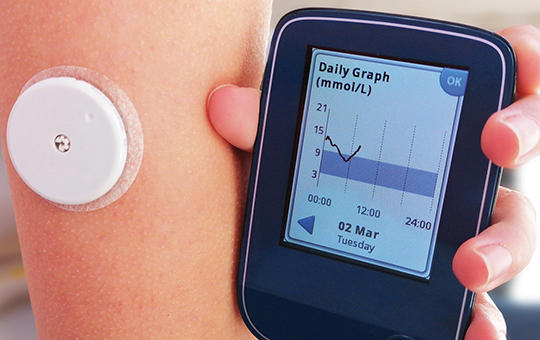The eLitMed.hu medical portal uses computer cookies for convenient operation. Detailed information can be found in the Cookie-policy.
Lege Artis Medicinae - 2024;34(9)
Content
[Continuous glusose monitoring in application of insulin glargine plus lixisenatide fixed ratio combination ]
[The effectiveness of the fixed-ratio combination of insulin glargine and lixisenatide (iGlarLixi) has been confirmed by several clinical trials in people with type 2 diabetes (T2DM). The aim of this study was to demonstrate the effectiveness of iGlarLixi treatment in improvement glycemic control in participants who were inadequately controlled on basal insulin using continuous glucose monitoring (CGM) data.
The primary endpoint of this 18-week, single-arm, open-label, phase 4 clinical trial was the change of blood glucose level time in range (TIR). The inclusion criteria were at least 3-year T2DM and 6-month treatment with basal insulin, HbA1c level ≥7.5% and ≤10% and fasting blood glucose level ≤7.8 mmol/l. CGM data recording was performed before the switch to iGlarLixi and at the 18th week. Dose titration of iGlarLixi was based on self-monitoring of blood glucose levels.
Overall 51 participants were treated with iGlarLixi and 34 participants had baseline and end-of-study CGM recordings (“per-protocol population”). The per-protocol population’s mean (SD) age was 66.4 (7.01) years and they have had T2DM for 16.6 (9.06) years at inclusion. The percentage of TIR increased from 71.8% (18.08) to 78.3% (12.36) (p=0.066), while the time above range (TAR) decreased significantly from 24.0% (18.96) to 9.9% (9.85; p<0.001). The percentage of time-below-range (TBR) increased from 4.2% (7.23) to 11.8% (13.48; p<0.001). The HbA1c level decreased from 8.4% (0.63) to 7.1% (0.91), and the fasting blood glucose levels also decreased.
This study confirmed the effectiveness of iGlarLixi using CGM data and provided numerous learnings for designing future CGM studies.]
[Failure in catching up – Part 1: Trends in Hungarian public expenditures on health in an international comparison ]
[Two longer-term trends lie behind the day-to-day perceptible crisis of the Hungarian healthcare system: the failure to catch up with the EU14 countries and the failure of reforming the healthcare system. The two-part study only deals with the first process: it shows that, in terms of many basic indicators of health expenditures and health status, Hungary has drifted away not only compared to the developed EU countries, but also compared to the other Visegrád (V4) countries. For example, in 1992, we had the highest public expenditure on health per capita in the V4 countries: it exceeded that of the Czech Republic by 24% and that of Poland by 90%, but in 2019 we reached only 52% of the Czech value, and the Polish expenditures exceeded the Hungarian one by 11%. The study separately analyses the longer-term trends between the beginning of the 1990s and the end of the 2010s and the period affected by Covid-19. This part analyses trends in public expenditure on health, and the second part outlines trends in two basic indicators of health status, life expectancy and avoidable mortality. Furthermore, the second part summarizes the conclusions of the study as a whole. ]
[The possible role of being a near-peer school health educator in medical education ]
[Lack of skills, commitment, and physicians’ poor health behavior may hinder lifestyle counseling in medical practice, but these barriers can be mitigated by training. We aimed to explore how school-based peer health education during training may improve medical education. We examined among educators of the Balassagyarmat Health Education Program (BEP) what kind of experiences they gained useful for lifestyle counseling, how committed they became to health education, and whether their health behavior changed.
Semi-structured interviews were conducted with medical student near-peer educators of BEP (n = 9) who had mastered all topics of the program. Our data were subjected to qualitative content analysis. Our deductive codes were defined by the research questions, and responses to these were inductively coded and aggregated along the questions.
Among the skills useful for lifestyle counseling, the participants experienced improvement in patient education, motivation, and partnership-building. They became more committed and after the program voluntarily and successfully carried out health education in their communities and among patients. They reported more conscious nutrition, alcohol consumption, and increased physical activity as changes in their own behavior.
The school-based health education program helped medical student near-peer educators improve medical communication skills and commitment to health education, and spurred positive health behavior change; thus, we recommend considering its integration into medical education.
]
[Prevalence and dietary treatment of the most common diseases and gastrointestinal symptoms in pregnancy ]
[A pregnant woman’s diet defines her own health as well as the healthy development and growth of the child in the womb. During pregnancy, a significant proportion of women experience some kind of unpleasant gastrointestinal symptom or illness, and most of them try to relieve those with dietary changes.
The quantitative, cross-sectional research was performed between January 2020 and May 2020. During the non-random convenience sampling, the target group consisted of Hungarian pregnant women (n = 721). In the self-administered, anonymous, online available questionnaire, sociodemographic, pregnancy and nutrition- related questions were used. The significance level was determined at p<0.05.
Nine out of ten pregnant women experienced at least one unpleasant symptom during their pregnancy. The highest proportion of pregnant women reported dieting due to illness, and the largest proportion tried to treat the symptoms by nutrition. We discovered a significant difference in terms of educational level and problem-specific dieting in case of illness, as well as income status and following a special diet due to food intolerance. Pregnant women mostly request advice from a doctor and then from a dietician to design a suitable diet, however, there was no statistically detectable difference in terms of higher education, higher income status and obtaining information from a dietician.
The education of pregnant women plays an important role in the effective dietary treatment of diseases and symptoms, which are experienced most often during pregnancy and can be relieved with proper nutrition.
]
[What can network science do to improve the state of play in medicine? ]
[The paper examines the complexity of the health care system and the new perspective opened up by the introduction of network science, with a focus on the Hungarian situation.
MAIN IDEAS – (1) The healthcare system is not composed of isolated elements, but of complex, superposed network layers, where different nodes (e.g. patients, doctors, hospitals) and different relationships (e.g. examinations, treatments, outpatient and inpatient episodes) interact with each other in a variety of ways. (2) We present different types of networks (random, small-world, scale-independent and centralized) and examine how they model healthcare processes. (3) We will show how network science helps to identify critical points in the system, problems of inefficiency and opportunities for improvement. (4) In analysing the hungarian situation, we will show that in the hungarian health care system, forced centralisation and rigid regulation often hamper efficient functioning, due to the inessential small-world and/or scale-independent nature of the care & cure system. The paper demonstrates through concrete examples how a network approach can be applied in health care (e.g. emergency/on-call care, hospital capacity planning).
Network science is a promising tool for better understanding and improving the health care system. Sectoral policy makers should take a network approach into account in order to develop a more efficient and flexible health system.]
1.
Clinical Neuroscience
Is there any difference in mortality rates of atrial fibrillation detected before or after ischemic stroke?2.
Clinical Neuroscience
Neuropathic pain and mood disorders in earthquake survivors with peripheral nerve injuries3.
Journal of Nursing Theory and Practice
[Correlations of Sarcopenia, Frailty, Falls and Social Isolation – A Literature Review in the Light of Swedish Statistics]4.
Clinical Neuroscience
[Comparison of pain intensity measurements among patients with low-back pain]5.
Journal of Nursing Theory and Practice
[Fear of Falling among Geriatric Patients: a Narrative Review]1.
2.
3.
4.
5.















